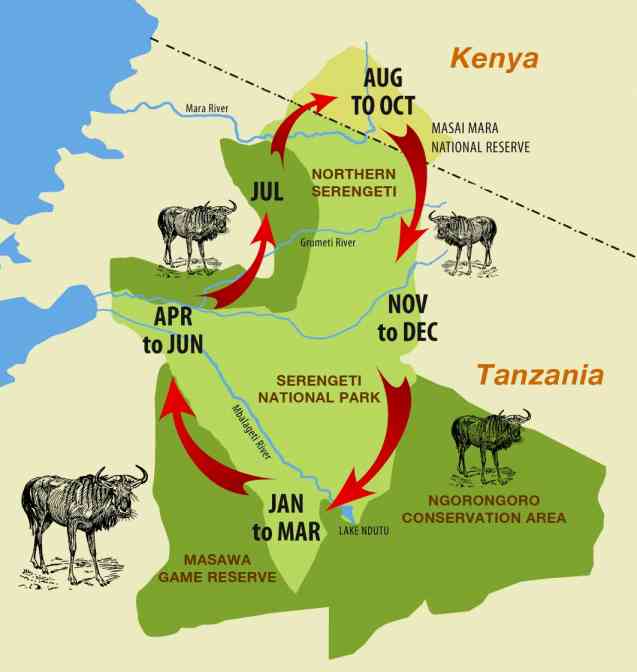Witnessing over a million wildebeests, zebras, and gazelles move in a synchronized dance across the plains of the Serengeti is nothing short of mesmerizing. The wildebeest migration is often considered one of the most spectacular wildlife events in the world. This natural wonder isn’t just fascinating; it’s an intricate life or death journey, showcasing the resilience and instincts of these creatures.
The best time to witness this awe-inspiring event depends largely on the specific phase of the migration you’d like to observe. Typically, the wildebeest migration peaks between July and October when the herds cross the treacherous Mara River, facing crocodile-infested waters. This period offers a thrilling yet harsher spectacle of survival, making it the most popular period for experts and enthusiasts alike.

When is the best time to see the wildebeest migration?
The wildebeest migration is one of the most impressive wildlife events on Earth. The best time to see this spectacle is between July and October. During this period, the wildebeests cross the Mara River into Kenya’s Maasai Mara Reserve. This part of the migration is particularly thrilling as the animals face many dangers, including crocodiles and swift currents. It’s a dramatic and unforgettable moment that attracts wildlife enthusiasts from all over the world.
From November to March, the herds find themselves in the Serengeti plains where the calving season takes place. According to this post, up to 500,000 calves are born during this time. Predators like lions and hyenas follow the herds, creating a dynamic and tense atmosphere. The lush green landscapes of the Serengeti provide stunning backdrops for photographers. It’s also a time when visitors can witness the circle of life in full swing.
In April and May, the herds move to the western corridor of the Serengeti. The migration during these months is less crowded with tourists, offering a more peaceful experience. The landscape starts to change, and the weather gets a bit wetter. This period is ideal for those who enjoy exploring less-traveled areas. According to the article here, this time is perfect for observing the massive groups of animals as they prepare for their northward journey.
If you plan to see the wildebeest migration, timing is key. Booking your trip well in advance is essential, especially if you aim to witness the river crossings. Different phases of the migration offer unique experiences. Whether you enjoy the drama of the river crossings or the new life during calving season, there is something for everyone. Visit the Great Migration to plan accordingly and experience this natural wonder at its best.
Understanding Seasonal Movements: Mapping the Wildebeest Journey
The wildebeest migration is a continuous cycle driven by the seasons. These animals move throughout the year, searching for fresh grass and water. Starting in the southern Serengeti, herds migrate northwest towards the Grumeti River by May. These movements depend heavily on the patterns of rainfall. A timely understanding of these patterns helps in predicting the migration path.
A major highlight of the migration occurs between July and October at the Mara River. Here, vast numbers of wildebeests face a dangerous crossing, battling strong currents and waiting predators. This crossing is a must-watch event for many wildlife lovers. The drama and tension at the river during this time can be overwhelming yet thrilling. It’s one of the most photographed events in the migration.
As December approaches, the herds return to the southern Serengeti plains. According to this post, this area serves as the base for calving, where thousands of young wildebeests are born. The lush grasslands provide ample nutrition for the nursing mothers. This period also attracts predators, making it an intense time for new life. Visitors can witness the daily struggle for survival and the beauty of new beginnings.
The entire migration covers an arc-shaped route spanning two countries, Tanzania and Kenya. This circular journey ensures the wildebeests utilize the best available resources annually. Keeping this route in mind, planning your trip around specific phases can enhance your experience. Look out for expert-guided tours that align with these migratory movements. Such planning will offer you the most rewarding views and experiences of this natural phenomenon.
The Prime Viewing Spots in the Tanzania safari
Tanzania offers some of the best viewpoints for watching the wildebeest migration. The Serengeti National Park is one of the top spots. During the dry season, particularly from June to October, the northern Serengeti near the Mara River is great for viewing river crossings. This area provides close-up views of the massive herds as they brave the waters. The dramatic scenes of survival and struggle are a highlight.
The Grumeti River, located in the western corridor of the Serengeti, is another excellent spot. Here, you can see the wildebeest migration from May to July. It’s a quieter place compared to the Mara River, meaning fewer tourists and more peaceful observation. The lush vegetation and abundant wildlife create a picturesque setting. This period also offers an excellent opportunity to see predators like lions and crocodiles in action.
For those interested in the calving season, the southern Serengeti plains are ideal. From December to March, this region becomes a nursery ground for young wildebeests. The vast plains offer panoramic views, making it easy to spot large herds and the newborns. This is an excellent time for photographers and nature lovers. The presence of predators adds an element of excitement, as they are drawn to the vulnerable calves.
In addition to these spots, the Ngorongoro Conservation Area offers unique viewing experiences. This area combines stunning landscapes with abundant wildlife. It’s also a great place to visit if you’re interested in the geological and cultural history of Tanzania. Utilizing expert guides from Lapet-faced Safari can amplify the experience, providing deeper insights into the [Tanzania Wildlife](https://www.lappetfacedsafaris.com/safari-in-tanzania/) and the migration patterns. Planning your visit around these prime viewing spots will ensure an unforgettable adventure.
Planning Your Trip: Tips for an Unforgettable Tanzania Wildlife Experience
Planning your trip to experience the Tanzania wildlife requires careful consideration. First, choose the right time of year to visit. The dry season, from June to October, is ideal for game viewing as animals gather around water sources. Make sure to book your accommodations and tours well in advance, especially during peak migration periods. This ensures you get the best view and experience.
Another key aspect is selecting the right safari tour. Professional guides from Lapet-faced Safari can greatly enhance your experience. They bring expert knowledge about animal behavior and the best spots to visit. Opt for guided tours that include both morning and evening safaris. This gives you a chance to see different animals active at various times of the day.
Packing the right gear is also essential for a memorable trip. Comfortable clothing, good walking shoes, and a hat are must-haves. Don’t forget your camera and binoculars for capturing magnificent wildlife. Travel light but make sure to pack essentials like sunscreen and insect repellent. A small first-aid kit can also be useful.
Safety is paramount when on a safari. Always follow the instructions given by your guide. Stay inside the vehicle unless told otherwise, and keep a safe distance from animals. Avoid loud noises and sudden movements that could startle wildlife. Professional guides ensure your journey is safe and enjoyable. Trust their expertise for the best experience.
To make the most of your visit, consider adding cultural tours to your itinerary. Engaging with local communities enriches your experience. You learn about the culture and traditions of the people in Tanzania. This adds a unique, personal touch to your adventure. Balancing wildlife viewing with cultural experiences makes for a holistic and unforgettable trip.
Finally, be mindful of conservation efforts. Support eco-friendly lodges and tours that prioritize sustainable practices. Respect the natural habitat and leave no trace. Your contribution helps in preserving Tanzania’s unique wildlife for future generations. These small efforts add up and make a significant impact. Enjoy your adventure responsibly.
Key Takeaways
- The best time to see the wildebeest migration is from July to October.
- You can witness dramatic river crossings during this period.
- The calving season occurs in January and February in the southern Serengeti.
- During calving season, thousands of calves are born creating an exciting spectacle.
- Plan your visit early and choose the right safari tour for the best experience.

